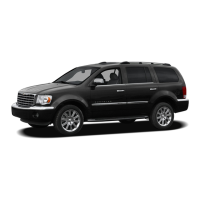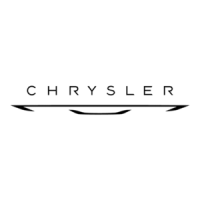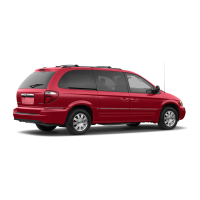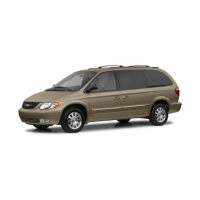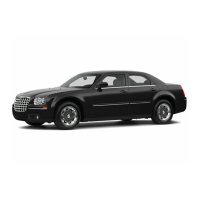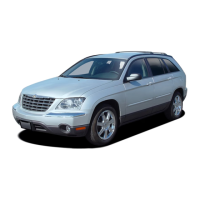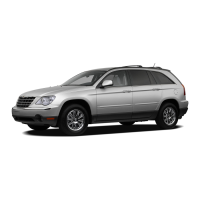
Do you have a question about the Chrysler ASPEN and is the answer not in the manual?
| Brand | Chrysler |
|---|---|
| Model | ASPEN |
| Category | Automobile |
| Language | English |
Lists the sections within the Introduction chapter.
Discusses the higher rollover risk of utility vehicles and safety precautions.
Guides the user on how to navigate and find information in the manual.
Explains warnings against operating procedures that could result in accidents or injury.
Details the location and importance of the Vehicle Identification Number.
Warns about the safety implications of modifying or altering the vehicle.
Information about the vehicle's ignition keys and key codes.
Step-by-step instructions on how to remove the ignition key.
Describes how to lock the vehicle's doors manually using the key.
Explains the Sentry Key Immobilizer system for preventing unauthorized vehicle operation.
Information on how to obtain and use replacement vehicle keys.
Procedure for programming new Sentry Keys to the vehicle.
Details how the ignition and steering systems lock for anti-theft protection.
Explains the feature that keeps power accessories active after the ignition is turned off.
Describes the vehicle's security alarm system's monitoring and operation.
Instructions on how to arm the vehicle's security alarm system.
Instructions on how to disarm the vehicle's security alarm system.
Describes how the interior lights illuminate when the doors are unlocked.
Explains how to use the key fob to lock/unlock doors and activate the panic alarm.
Step-by-step guide to unlocking the doors and liftgate using the key fob.
Step-by-step guide to locking the doors and liftgate using the key fob.
Instructions on how to enable or disable the horn chirp feature.
Instructions on programming the flash lights feature with lock/unlock.
Details how to activate and cancel the vehicle's panic alarm.
Provides general information about the remote lock control system and its compliance.
Instructions for programming additional key fobs for the remote lock control.
Guide on how to replace the battery in the key fob transmitter.
Explains how to use the remote starting system to start the vehicle from a distance.
General section on door locking mechanisms.
Describes how to manually lock the doors from the inside.
Explains the operation of power door lock switches located on the door trim panels.
Details how the door locks automatically engage when the vehicle speed exceeds 15 mph.
Instructions for programming or disabling the automatic door lock feature.
Explains the feature that unlocks all doors when any door is opened after the vehicle has been shifted to PARK.
Customer programming sequence to enable or disable the auto unlock on exit feature.
Describes the child protection door lock system for rear doors.
Section covering the operation of the vehicle's windows.
Explains the control for all four power windows on the driver's door trim panel.
Details the Auto Down feature for the driver's and front passenger's window.
Explains the Auto Up feature with anti-pinch protection for front windows.
Procedure to reset the Auto Up feature if it stops working.
Explains how the window lockout switch on the driver's door disables window controls on other doors.
Information on how to unlock and open the liftgate.
Details how to open and close the power liftgate using the transmitter or overhead console.
Covers essential safety features like seat belts and airbags for occupant protection.
Explains the operation and safety of the vehicle's combination lap/shoulder belts.
Step-by-step guide on how to properly use the lap/shoulder belts.
Details how to adjust the upper shoulder belt anchorage for better positioning.
Information on the seat belt assembly in the second row center seating position.
Explains the ALR mode where the shoulder belt is automatically pre-locked for child seats.
Describes the center three-point seat belt for the third-row rear seat and its disconnection for folding.
Explains the pretensioning devices in front seat belts designed to remove slack during a collision.
Describes the system that alerts the driver to buckle their seat belt.
Recommendations for pregnant women on how to use seat belts safely.
Information on how to use a seat belt extender if the existing belt is not long enough.
Details the vehicle's airbag system, including driver and passenger front airbags.
Explains the components and operational logic of the airbag system.
Lists the various components that make up the airbag system.
Crucial safety warnings about airbags, luggage placement, and vehicle modifications.
Explains what happens when the airbag system deploys and the system's behavior.
Provides guidance on maintaining the vehicle's airbag system and when to seek service.
Information about the EDR's function to record vehicle data prior to airbag deployment.
Essential information on properly restraining babies and children in the vehicle.
Specific guidance for restraining infants and small children, including rearward-facing seat restrictions.
Information on forward-facing child seats and convertible child seats for older children.
Guidance for children who have outgrown booster seats and should use lap/shoulder belts.
Tips on selecting, fitting, and properly installing child restraint systems.
Explains the LATCH system for child restraint installation without using seat belts.
Instructions for correctly installing LATCH-compatible child restraint systems.
Procedure for installing child restraints using the vehicle's seat belts.
Information on tether strap anchorages for third-row seating child restraints.
Guidance on the proper break-in procedure for a new vehicle's engine.
General safety advice related to vehicle operation and maintenance.
Precautions and maintenance advice related to the vehicle's exhaust system and carbon monoxide.
A checklist of safety inspections to perform inside the vehicle.
Instructions on inspecting the heater defroster ducts for proper operation.
Guidance on inspecting seat belt systems for wear and damage.
How to interpret and react to the airbag system warning light.
A checklist of safety inspections to perform on the outside of the vehicle.
Information on examining tires for wear, damage, and proper inflation.
Instructions on checking the operation of all exterior lights.
Checks for proper door closing, latching, and locking.
How to check for and address fluid leaks under the vehicle.
Information on interior and exterior mirrors, including adjustment and features.
Explains how to adjust and use the inside day/night rearview mirror.
Details the automatic adjustment feature to reduce headlight glare from vehicles behind.
Guidance on adjusting outside mirrors for maximum benefit and visibility.
Describes the hinged exterior mirrors that can be moved to resist damage.
Explains the controls for power mirrors located on the driver's door panel.
Describes the illuminated vanity mirrors on each sun visor and their operation.
Explains how heated mirrors are activated with the rear window defroster switch.
Details the automatic adjustment of the driver's side mirror to reduce headlight glare.
Information on the voice-activated, hands-free communication system.
Explains how to use voice commands to operate the UConnect system and navigate menus.
A graphical representation of UConnect voice commands and their hierarchy.
Explains the Voice Recognition system's capabilities and best practices for use.
Lists global and local commands understood by the Voice Recognition System.
How to adjust the volume for the voice recognition system.
How to access the main menu from the voice recognition system.
Commands for operating the AM radio band using voice recognition.
Commands for operating the FM radio band using voice recognition.
Instructions for switching to and operating the satellite radio mode.
Commands for operating the CD player and navigating disc modes.
Instructions for using the voice recorder mode to create and manage memos.
Feature to train the system to recognize user's voice commands and numbers for improved performance.
Section dedicated to the operation and adjustment of vehicle seats.
How to adjust the front seats manually using the lever located near the floor.
Explains the operation of seatback recliners using a lever on the side of the seats.
Details how to adjust manual lumbar support using a lever on the seat.
Information on adjusting head restraints to reduce whiplash injury risk.
Explains the switches for the driver's 8-way power seat adjustment.
Details the switches for the front passenger's 4-way power seat adjustment.
Describes the feature for heating driver, front passenger, and second-row seats.
Instructions on how to fold and tumble the second-row bucket seats for access.
Information on the fold-and-tumble feature of the 40/20/40 split second-row seat configuration.
Details the process of folding the third-row seat bench in two stages.
Instructions for folding the third-row 60/40 split seat.
Explains how the memory buttons recall saved seat, mirror, pedal, and climate settings.
Step-by-step guide for setting memory positions and linking RKE transmitters.
How to recall saved memory positions for the driver's seat, mirrors, and pedals.
Procedure to disable a linked Remote Keyless Entry transmitter from memory.
Explains the self-limiting control for power seat and pedal movement to prevent unintended limitations.
Describes the automatic seat positioning feature to enhance driver mobility in/out of the vehicle.
Instructions on how to open and close the vehicle's hood.
Covers the operation and control of various vehicle lights.
Shows the location of the headlight switch on the steering column.
Explains the different positions and functions of the headlight switch.
Details the operation of interior courtesy and reading lights.
How to adjust the brightness of the instrument panel lighting and use the "Parade mode".
Explains the load shedding feature to protect the vehicle's battery life.
Describes the feature that keeps headlights on for 90 seconds to aid exit.
How to activate automatic headlights based on ambient light conditions.
Explains how to turn on parking lights, taillights, and headlights.
How headlights turn on for 90 seconds when the RKE UNLOCK button is pressed.
Explains the operation of daytime running lights in Canada.
The chime that sounds if lights are left on after the ignition is turned off.
How to turn on fog lights and their operating conditions.
Describes the controls for turn signals, headlights, and wipers located on the steering column.
How to use the lever to signal right-hand or left-hand turns and lane changes.
Tapping the lever once flashes the signal three times and automatically turns it off.
How to signal another vehicle with headlights by momentarily activating high and low beams.
How to switch headlights between high and low beam.
Section covering the operation of windshield wipers and washers.
Explains how to select wiper speed using the switch on the multifunction control lever.
Details the intermittent wiper feature and how to adjust the delay interval.
How to use the washer knob to spray washer fluid and operate wipers.
Instructions on how to tilt and lock the steering column for driver comfort and safety.
Explains the power adjustable accelerator and brake pedals for driver comfort.
Steps for adjusting the driver's seat and pedals for optimal position.
Information on how to activate and use the electronic speed control (cruise control) system.
Steps to activate the vehicle speed control system.
How to set a desired speed using the cruise control system.
How to deactivate the cruise control system without erasing the set speed.
How to resume a previously set speed using the cruise control system.
How to increase or decrease the set speed for cruise control.
How to accelerate temporarily for passing while cruise control is engaged.
Explains the system that helps drivers detect obstacles when backing up.
Describes the visible and audible warnings provided by the rear park assist system.
Chart showing obstacle distances, LED colors, and audible signals for the rear park assist.
Information on the rear camera system that displays an on-screen image of the rear of the vehicle.
Details the features located in the overhead console.
Explains how courtesy lights operate when doors are opened or the UNLOCK button is pressed.
Information on programming the HomeLink buttons to operate garage door openers and other devices.
Step-by-step instructions for programming HomeLink buttons.
Procedures for programming HomeLink for garage door openers manufactured after 1995 with rolling codes.
Special programming procedures for gate operators and Canadian radio-frequency laws affecting HomeLink.
How to operate the trained HomeLink buttons for various devices.
Instructions on how to reprogram a single HomeLink channel.
Advice on erasing HomeLink channels before selling or turning in the vehicle.
Common solutions for problems encountered when programming HomeLink.
Details the operation of the power sunroof and sunshade controls.
How any movement of the sunroof switch stops operation and leaves it in a partial open position.
Explains wind buffeting and how to minimize it by adjusting windows or sunroof.
Guidance on cleaning the sunroof glass panel.
Information about the vehicle's auxiliary power outlets and their operation.
Details the 115V inverter outlet for powering electronics and cell phones.
Precautions regarding using vehicle outlets when the engine is off to avoid battery discharge.
Instructions on how to reconfigure power outlets to operate with or without ignition.
Describes the features and storage compartments of the front floor console.
Lists the features of the floor console between the driver and front passenger seats.
Information about the location and access to the vehicle's cupholders.
Details the front center console's storage bin and removable mat.
Explains the console's power outlet, portable phone storage bin, and cord routing.
Lists the features of the rear floor console located between the second-row seats.
Information on the load capacity and proper distribution for the roof luggage rack.
Describes the removable cargo liner and organizer system.
General overview of the vehicle's instruments and controls.
Focuses on the instrument cluster, including its layout and components.
Detailed explanation of each gauge and indicator within the instrument cluster.
Explains the fuel gauge's function in showing the fuel level in the tank.
Describes the temperature gauge indicating engine coolant temperature and overheat warnings.
Explains the function of the arrow lights indicating turn signal direction and operation.
Indicates when the fuel gauge reads 1/16 of a tank or less.
Shows that the headlights are currently on high beam.
Reminds the driver to buckle up; remains on if the seat belt is unbuckled.
Warns of an overheated engine condition and provides actions to take.
Shows the current speed of the vehicle.
Monitors the electrical system voltage, indicating charging system issues.
Indicates when the vehicle security alarm is arming or set.
Monitors the Anti-Lock Brake System, indicating malfunction and required service.
Indicates when the engine oil pressure has become critically low.
Measures engine Revolutions-Per-Minute (RPM x 1000).
Displays the position of the automatic transmission shift lever and its relation to other positions.
Shows the total distance driven and allows tracking of trip mileage.
Displays messages for conditions like door ajar, low washer fluid, or oil change needs.
Indicates when the engine oil needs to be changed based on mileage or time.
Warns of problems with the Electronic Throttle Control system, indicating potential drivability issues.
Warns of brake system issues, such as parking brake not released or low brake fluid.
Indicates malfunctions in the Electronic Stability Program or Brake Assist System.
Monitors emissions and engine control systems, warning of potential engine problems.
Illuminates to warn of low tire pressure or a malfunction in the TPMS.
Information on the digital clock display and its timekeeping function.
Step-by-step instructions for setting the digital clock time.
How to set the analog clock located at the top center of the instrument panel.
General information about radio broadcast signals, AM/FM reception, and electrical disturbances.
Details the REN Multimedia System, including radio, CD/DVD, USB, and HDD.
Reference to the Radio-specific manual for satellite radio operating instructions.
Reference to Section 3 for Voice Recognition System operating instructions.
Reference to Section 3 for UConnect hands-free communication operating instructions.
Instructions for setting the clock on the multimedia system's touch screen.
How to change the clock setting to display daylight savings time.
Feature to display time on the touch screen when the multimedia system is turned off.
Instructions for changing the time zone setting for the multimedia system's clock.
Details the RER Multimedia System, including radio, Sirius Satellite Radio, navigation, and UConnect.
Reference to the Navigation User's Manual for detailed satellite radio operating instructions.
Reference to the Navigation User's Manual for UConnect operating instructions.
Explains how the GPS receiver synchronizes the clock and how to set time zones and daylight savings.
How to select a time zone for the GPS synchronized clock.
How to change the clock setting to daylight savings time for the GPS clock.
Manual adjustment of the clock time if it differs from the system clock.
Feature to display time on the touch screen when the radio is turned off.
Details the RES radio system with CD player, MP3, and AUX jack functionality.
Notes that the ignition switch must be in ON or ACC to operate the radio.
How to turn the radio on/off and control volume using the rotary knob.
Explains the continuous electronic volume control and its behavior when the audio system is turned on.
How to use SEEK buttons to search for listenable stations in AM/FM or CD/MP3 modes.
How the SCAN button causes the tuner to search for listenable stations.
Reference to Section 3 for Voice Recognition System operation related to the radio.
How to use the voice recognition button to operate the UConnect Hands-Free Phone feature.
How to use the PHONE button to operate the UConnect Hands-Free Phone feature.
How to display the time of day and switch between time and frequency displays.
Step-by-step instructions for setting the clock on the RES radio.
How to cycle through TAG information (Song Title, Artist, Composer) for RDS stations.
How to use Rewind/Fast Forward buttons to search for frequencies or tracks.
How to turn the rotary knob to increase or decrease radio frequency or channel.
How to adjust bass, mid, treble, balance, and fade settings for audio output.
How to select program format types for radio stations, which may not broadcast this information.
How to access setup options, including setting the clock and selecting radio modes.
How to select AM or FM radio modes.
Procedure for storing radio stations into pushbutton memory.
How these buttons tune the radio to preset stations stored in memory.
How to switch between AM/FM modes and Disc modes.
Instructions for playing audio from CDs and MP3s.
How to gently insert a CD into the player for automatic loading.
How to use SEEK buttons to navigate tracks in CD or MP3 modes.
How the SCAN button plays the first five seconds of each track.
How to change the display to show the time of day in auxiliary mode.
Reference to Section 3 for UConnect operating instructions.
Reference to the Satellite Radio section for operating instructions.
Reference to the VES™ User's Guide for detailed operating instructions.
Information about Sirius Satellite Radio service, channels, and subscription activation.
How to activate the Sirius Satellite Radio service.
How to access the ESN/SID needed to activate Sirius Satellite Radio.
Procedure to access ESN/SID for REQ radio models.
Procedure to access ESN/SID for RER/REN radio models.
How to select the satellite radio mode by pressing the SAT button.
Advice on optimal antenna placement and avoiding signal blockage for satellite reception.
Reasons why satellite reception may be interrupted, such as parking structures or tree coverage.
Notes that the ignition switch must be in ON or ACC to operate the radio in satellite mode.
How the SCAN button searches for the next channel in Satellite mode.
How to turn the rotary knob to increase or decrease the satellite channel.
How to select the program format type for satellite radio.
How to access setup options, including displaying Sirius ID number and setting pushbutton memory.
Procedure for storing satellite channels into pushbutton memory.
How these buttons tune the radio to satellite channels stored in memory.
Information on connecting an iPod or other digital device to the vehicle's sound system via the UCI connector.
Instructions for connecting an iPod to the vehicle's UCI connector.
How to control the iPod using radio faceplate buttons to access UCI mode and play audio.
How to use radio buttons to control the iPod in Play mode and display data.
How to use the knob to navigate tracks and display iPod information on the radio.
How to move backward through tracks or to the beginning of the current track.
How to move forward through tracks or jump to the next track.
How to use SEEK buttons to move to the previous or next track.
How to view track information (Title, Artist, Album) and navigate data screens.
How to repeat the current playing track.
How SCAN plays the first five seconds of each track and then forwards to the next song.
How to switch between shuffle on and shuffle off modes for iPod playback.
How to enter List mode to scroll through menus and tracks on the iPod device.
How radio preset buttons are used as shortcuts to iPod lists like Playlists, Artists, Albums.
How the LIST button navigates to the top-level menu of the iPod.
How the MUSIC TYPE button acts as a shortcut to the genre listing on the iPod.
Information on the optional Video Entertainment System (VES) with DVD player, LCD screen, and remote control.
Details the remote sound system controls located on the rear surface of the steering wheel.
How to use the right-hand switches to adjust volume and change audio modes.
How to use left-hand switches to SEEK stations or tune to programmed presets.
How to use left-hand switches to navigate tracks in CD or MP3 modes.
Precautions for keeping compact discs in good condition for optimal playback.
How cellular phones in the vehicle can affect radio performance and recommendations for relocation or volume adjustment.
Section detailing the manual and automatic climate control systems.
Describes the operation of the manual air conditioning and heating system.
Steps to turn the air conditioning ON or OFF using the Snowflake (A/C) button.
How to regulate the amount of air delivered to the passenger compartment using the blower control knob.
Allows selection of different air distribution patterns for the front climate control.
How to use recirculation mode to block outside air when interior air quality is poor.
Air flows through outlets in the instrument panel, adjustable to direct airflow.
Air flows through outlets in the instrument panel and those located on the floor.
Air flows primarily through floor outlets with a small amount directed to defrost outlets.
Outside air flows in equal proportions through floor and defroster outlets.
Air directed to the windshield through the defroster outlet.
How to control air temperature using a slide control on the top center of the panel.
How second and third-row passengers can control rear blower speed and temperature.
Reference to Section 4 for rear window features.
Details the rear compartment control for blower speed and temperature.
How second-row occupants control rear blower speed.
How second-row occupants control rear temperature.
Chart showing where rear airflow comes from based on front control selection.
Tips for optimizing climate control operation in various weather conditions.
Procedure for achieving a fast cooldown in hot weather.
How to clear interior fogging on windows by adjusting climate controls.
Steps to follow before starting the vehicle, including seat and mirror adjustment.
Explains the starting system where the driver doesn't need to hold the key in the START position.
What to do if the engine fails to start, possibly due to flooding.
Information on operating the automatic transmission and selecting gear positions.
Explains the system preventing gear shift movement without brake pedal depression.
Details the different gear ranges (P, R, N, D, 2) and their proper usage.
How the PARK position supplements the parking brake and its usage.
When to use the REVERSE gear range, only after the vehicle has come to a complete stop.
When to shift to NEUTRAL for prolonged periods with the engine running, and its implications for towing.
Suitable for most city and highway driving conditions.
For slow driving in heavy city traffic, mountain roads, or for engine braking on steep grades.
Explains the electronically controlled fourth and fifth speeds (Overdrive) and when the transmission shifts into them.
When to activate TOW/HAUL mode for improved performance and reduced transmission stress during towing or heavy loads.
Describes the clutch feature that improves fuel economy by engaging at calibrated speeds.
Explains the operation and modes of the four-wheel drive system.
Information on the single-speed NV 140 transfer case for full-time 4WD.
Describes the Normal 4-Wheel Drive High Range and its function.
Information on the electric-shift NV 244 Generation II transfer case and its modes.
Step-by-step instructions for shifting the NV 244 Generation II transfer case between modes.
Precautions to observe when driving on wet or slushy roads to avoid hydroplaning.
Advice on driving through water and ensuring safety to prevent vehicle damage.
Warnings about the dangers of driving through flowing or rising water.
Cautions and warnings to consider when driving through shallow standing water.
Information on the foot-operated parking brake and its proper application.
Details the function of the brake system, including power assist loss and hydraulic system capability.
Explains how the ABS aids driver control under adverse braking conditions by preventing wheel lock-up.
Critical warnings about ABS system limitations and proper usage to avoid accidents.
Information on the standard power steering system and its response.
Explains the advanced electronic brake control system, including ABS, BAS, TCS, ERM, ESP, and TSC.
Details how the BAS optimizes braking capability during emergency braking maneuvers.
How TCS monitors wheel spin and applies brake pressure or reduces engine power for stability.
How ERM anticipates potential wheel lift by monitoring steering input and vehicle speed.
How ESP enhances directional control and stability by applying brakes to counteract over/under steering.
Describes the normal operating mode for ESP in 4WD LOCK and 2WD vehicles.
How to enter Partial Off mode for improved traction in deep snow, sand, or gravel.
Explains the 4WD LOW range for low speed 4-wheel drive with additional traction and pulling power.
Explains the malfunction indicators for ESP, BAS, and TCS systems.
How TSC uses sensors to recognize and counteract trailer sway.
Information on tire markings, grades, and safety.
Explains the markings on tire sidewalls, including size designation, load index, and speed symbol.
How to find and interpret the TIN, including DOT, manufacturer location, size, and date code.
Information on the placard that details vehicle capacity, tire size, and inflation pressures.
How to determine maximum loading conditions by considering occupant and cargo weights.
A step-by-step guide to calculating available cargo and luggage load capacity.
General information about tire pressure, its effects on safety, economy, and ride comfort.
Importance of proper tire inflation pressure for safe and satisfactory vehicle operation.
Where to find proper cold tire inflation pressure information.
Importance of correct tire inflation for high-speed driving and potential requirements for increased pressure.
Warnings about combining radial ply tires with other types and proper use of radial tires.
Information on the temporary use and limitations of a compact spare tire.
Details about the limited-use spare tire for temporary emergency use.
Warnings and precautions against spinning vehicle wheels when stuck.
How to use tread wear indicators to determine when tires need replacement.
Factors affecting a tire's service life, including driving style, pressure, and distance.
Recommendations for using tires equivalent to original equipment for safety and performance.
How poor alignment can lead to fast tire wear, uneven wear, and vehicle pull.
Information on tire pressures for light load vehicle conditions.
Guidelines for using "Class S" tire chains or other traction aids.
Recommendations for using snow tires, including size, type, and inflation pressures.
Why tire rotation is important for even wear and performance.
Explains how the TPMS warns the driver of low tire pressure and system malfunctions.
How the base TPMS uses wireless technology to monitor tire pressure levels.
How the premium TPMS uses wireless technology with wheel rim mounted sensors to monitor tire pressure.
How to interpret TPMS messages and what they indicate about tire pressure or system faults.
Information on recommended gasoline octane ratings and the use of premium gasoline.
Explains the use of cleaner-burning reformulated gasoline and its benefits.
Information on blends containing oxygenates like ethanol, MTBE, and ETBE.
Details about the manganese additive MMT in gasoline and its potential effects.
Information on detergent additives and other fuel additives.
Crucial warnings about the dangers of carbon monoxide in exhaust gases and precautions to avoid poisoning.
Guidance on refueling the vehicle, including fuel filler cap usage and avoiding spills.
Importance of the gas cap and its role in the emission control system.
How to address the message indicating a loose or damaged fuel filler cap.
Information specific to Flexible Fuel Vehicles (FFVs) and E-85 fuel.
Explains the E-85 fuel filler cap and its relation to E-85 operation.
Defines E-85 as a mixture of ethanol and unleaded gasoline.
Information on using unleaded gasoline, E-85 fuel, and recommended refueling patterns.
Characteristics of E-85 fuel at low temperatures and potential drivability issues.
Expected decrease in fuel consumption and driving range when using E-85 compared to gasoline.
Ensuring vehicle service uses correct ethanol-compatible parts for Flexible Fuel Vehicles.
Information on vehicle loading, weight ratings, and payload capacity.
Details about the certification label on the driver's door, including VIN and weight ratings.
The total permissible weight of the vehicle, including occupants, cargo, and options.
Definition of payload as the allowable load weight the vehicle can carry.
Maximum permissible load on the front and rear axles and proper load distribution.
Minimum allowable tire size for the vehicle and replacement tire load capacity requirements.
The appropriate rim size for the tire size listed.
The cold tire inflation pressure for all loading conditions up to full GAWR.
The total weight of the vehicle with fluids, but no occupants or cargo.
How to determine actual total weight and distribution by weighing the loaded vehicle.
Warnings about the dangers of overloading the vehicle and its impact on handling and parts.
Safety tips and information on towing limits and requirements for trailers.
Definitions of trailer towing terms to help understand towing information.
The total allowable weight of the vehicle and trailer combination.
The weight of the trailer plus all cargo, consumables, and equipment loaded in or on it.
The total permissible weight of the vehicle and trailer combined.
Maximum capacity of the front and rear axles and the importance of even load distribution.
The downward force exerted on the hitch ball by the trailer, considered part of the vehicle's load.
The maximum height and width of the front of a trailer.
How TSC uses sensors to recognize and counteract trailer sway by applying brakes or reducing engine power.
Electronic TSC system that automatically attempts to stop trailer sway.
Mechanical trailer sway control that uses a telescoping link to dampen unwanted swaying.
Supports trailer tongue weight and is commonly used for small to medium-sized trailers.
Uses leverage through spring bars to distribute trailer tongue weight to vehicle axles.
A special high platform hitch that mounts over the rear axle in the truck bed for connecting fifth-wheel trailers.
Industry standard chart for maximum trailer weight by hitch class, aiding in selection.
Information on maximum trailer weight ratings and website addresses for additional towing info.
How to load a trailer with 60-65% of weight in the front for proper tongue weight distribution.
Guidelines for proper break-in of drivetrain components and vehicle operation during towing.
Do not tow using a compact spare tire; ensure proper tire inflation and check for wear/damage.
Do not interconnect vehicle and trailer hydraulic or vacuum brake systems to avoid inadequate braking.
Warnings about connecting trailer brakes, increasing stopping distance, and potential accidents.
Requirements for trailer stop lights and turn signals, and the use of trailer wiring harnesses.
How to use TOW/HAUL feature for improved performance and transmission life when towing.
Don't use speed control in hilly terrain or with heavy loads; disengage if speed drops significantly.
Actions to take to reduce potential for engine and transmission overheating during towing.
Warning against using the vehicle for snowplow applications due to potential damage and airbag system interference.
Information on recreational towing for 2WD and 4WD models, with cautions regarding transmission damage.
Recreational towing of 2WD models is not allowed due to severe transmission damage risk.
Cautions for 4WD models with NV 140 Transfer Case, which may not have a NEUTRAL position for towing.
Procedure to prepare the vehicle for recreational towing by shifting the transfer case into NEUTRAL.
Procedure to prepare the vehicle for normal usage after recreational towing.
Location and information contained on the equipment identification plate on the hood inner surface.
Covers emergency procedures such as hazard flashers, tire changing, and jump-starting.
Information on the flasher switch located behind the steering wheel for emergency signaling.
Detailed instructions on how to safely jack up the vehicle and change a tire.
Shows where the scissor jack and tire changing tools are stowed under the second-row seat.
Step-by-step instructions for safely jacking the vehicle to change a tire.
Instructions on how to remove the spare tire located underneath the vehicle in the rear.
Shows the location of the spare tire underneath the vehicle's rear.
Explains how to use the jack wrench extension to operate the spare tire winch.
Detailed procedure for safely changing a vehicle tire using the provided jack.
Steps to prepare the vehicle for tire changing, including parking surface and hazard flashers.
General instructions for changing a tire, including wheel nut loosening and blocking wheels.
Shows the correct location to place the jack when changing a front wheel.
Shows the correct location to place the jack when changing a rear wheel on the left side.
Shows the correct location to place the jack when changing a rear wheel on the right side.
Warnings about raising the vehicle too high, loose tires, and proper stowage of tools.
Warnings about loose tires or jacks causing injury in collisions or hard stops.
Instructions on how to properly stow the flat or spare tire and wheel assembly.
Step-by-step instructions for safely jump-starting a vehicle with a discharged battery.
Safety warnings about battery fluid, hydrogen gas, and booster battery voltage.
Warnings about connecting jumper cables improperly, especially in cold weather.
How to free a vehicle stuck in snow, sand, or mud using a rocking motion.
Information on the location and proper use of emergency tow hooks for off-road recovery.
Warnings about the limitations and proper use of tow hooks, and standing clear during pulling.
Cautions regarding the emergency-only use of tow hooks to avoid vehicle damage.
Proper procedures for towing a disabled vehicle to prevent damage and ensure safety.
Recommended methods for towing 4WD vehicles, such as flatbed or towing dolly.
Procedures for towing 2WD vehicles with the transmission in NEUTRAL and ignition OFF.
Covers vehicle maintenance tasks, including engine, fluids, filters, and appearance care.
Diagram identifying key components in the engine compartment for the 4.7L V-8 engine.
Diagram identifying key components in the engine compartment for the 5.7L HEMI V-8 engine.
Explains the OBD II system's role in monitoring emissions, engine, and transmission control systems.
Cautions about prolonged driving with MIL on and the need for servicing before emissions tests.
How the diagnostic system detects a loose fuel filler cap and the procedure to address it.
Legal requirements for emissions inspections and how the OBD system readiness is checked.
Recommendation to use genuine Mopar parts for maintenance and repairs to ensure performance.
Information about authorized dealer services, qualified personnel, and special tools.
Covers required maintenance services determined by engineers for optimal vehicle performance.
Information on checking and changing engine oil.
Best times and methods to check the engine oil level for accuracy.
Cautions about overfilling or underfilling the crankcase and potential engine damage.
Follow maintenance schedule for recommended oil and filter change intervals.
Specific maintenance recommendations for 4x4 models used off-road, focusing on air cleaners.
Special attention to air cleaners and crankcase ventilation in dusty environments to prevent abrasive material entry.
Recommendations for API certified engine oils meeting DaimlerChrysler Material Standard MS-6395.
Recommended SAE 5W-20 engine oil for all operating temperatures, improving low-temperature starting and fuel economy.
Guidance on using synthetic engine oils provided they meet recommended quality requirements.
Strong recommendation against adding any additives to engine oil, as it may impair performance.
Careful disposal of used engine oil and filters to protect the environment.
The engine oil filter should be replaced at every engine oil change.
Manufacturer recommends full-flow type oil filters for replacement; Mopar filters are recommended.
Information on drive belts, automatic tensioners, and inspection for wear or damage.
Importance of spark plugs for engine performance and emission control; replacement intervals.
Caution against overtightening spark plugs during replacement to avoid damage.
Follow maintenance schedule for recommended engine air cleaner filter change intervals.
Warning about the air cleaner's role in engine backfire protection and safety during removal.
How a plugged fuel filter can cause stalling, limit speed, or cause hard starting.
Requires unleaded fuel only; proper engine tuning is important for catalyst operation and damage prevention.
Damage to catalytic converter can result from improper vehicle condition or engine malfunction.
Hot exhaust systems can ignite flammable materials; do not park over burnable items.
The top of the maintenance-free battery is sealed; no water addition or periodic maintenance is required.
Safety warnings about battery fluid, hydrogen gas, and battery posts.
Essential steps for attaching battery cables correctly and using a charger safely.
Checking power steering fluid level only if a leak is suspected or system is not functioning properly.
Fluid level checks should be on level ground with the engine off; do not overfill.
Recommended checking and servicing of the air conditioner at the start of warm season.
Use only manufacturer-approved refrigerants and lubricants; system contains high-pressure refrigerant.
Inspect ball joints and seals for leakage or damage; replace damaged seals promptly.
Periodic lubrication of CV joints is not required; inspect joint boots for leakage or damage.
Lubricate locks, pivot points, seat tracks, doors, liftgate, and hood hinges periodically for rust and wear protection.
Clean wiper blades and windshield periodically with mild soap and water to remove buildup.
Checking fluid level in the shared reservoir and refilling with washer solvent only.
Cautions that commercially available windshield washer solvents are flammable.
Best protection against carbon monoxide is a properly maintained engine exhaust system.
Exhaust gases can injure or kill; contain colorless, odorless carbon monoxide.
Warnings about hot coolant and steam; never open a hot cooling system pressure cap.
Check engine coolant protection every 12 months; drain, flush, and refill if coolant is dirty or rusty.
System should be drained, flushed, and refilled at intervals shown on maintenance schedules.
Use only manufacturer-recommended coolant; refer to "Engine Coolant" for correct type.
Mixing coolants other than specified HOAT may damage the engine and reduce corrosion protection.
Use the same recommended coolant throughout the vehicle's life for extended maintenance intervals.
Cap must be tightened to prevent coolant loss and ensure return to radiator.
Safety warnings about opening a hot cooling system pressure cap to prevent burns or injury.
Inspect fuel system hoses and vacuum harnesses for heat and mechanical damage.
Ensures PCV valve is free of sticking or plugging; check hoses and passages for proper operation.
Information on power disc brakes, their adjustment, and performance under various conditions.
Disc brakes do not require adjustment; hard stops during break-in are recommended to seat linings.
Checking fluid level in master cylinders and the importance of using correct brake fluid.
Warnings about using incorrect or unidentified brake fluid, which may cause failure.
Overfilling brake fluid reservoir can spill fluid onto hot engine parts, causing fire.
Do not allow petroleum-base fluid to contaminate brake fluid, as seal damage may result.
Inspect hydraulic brake hoses for cracking, scuffing, or worn spots; replace immediately if damage is evident.
Worn brake hoses can burst, causing brake failure and accidents; replace immediately if signs of wear are present.
Information on checking automatic transmission fluid level at normal operating temperature.
Procedure for checking automatic transmission fluid level using the dipstick.
Using incorrect transmission fluid can cause deterioration in shift quality or torque converter shudder.
Inspect transfer case for fluid leaks; service immediately if a leak is evident.
Damage may result from operating the vehicle with low transfer case fluid.
Follow maintenance schedule for recommended transfer case fluid change intervals.
Refer to "Transfer Case" under Fluids, Lubricants and Genuine Parts for correct fluid type.
Refer to "Front or Rear Axle" under Fluids, Lubricants and Genuine Parts for correct fluid type.
Follow maintenance schedule for recommended axle fluid change intervals.
Recommendations for vehicle body care to maximize corrosion resistance.
Factors affecting paint and metal trim, and how to maintain corrosion resistance.
Corrosion is the result of deterioration or removal of paint and protective coatings from your vehicle.
Always wash your vehicle regularly in the shade with mild car wash soap.
Do not use abrasive or strong cleaning materials that can scratch metal and painted surfaces.
Hose off the undercarriage monthly if driving on salted/dusty roads or near the ocean.
Clean wheels and trim regularly with mild soap and water to prevent corrosion.
How to clean YES Essentials seats by blotting with clean towels.
Using Mopar cleaners for fabric upholstery, vinyl trim, and leather upholstery.
Do not use volatile solvents for cleaning as they are flammable and can cause respiratory harm.
Procedures for cleaning plastic headlights to avoid scratching and maintain light output.
Clean all glass surfaces regularly with household glass cleaner; avoid abrasive cleaners.
Care must be taken to avoid scratching plastic instrument cluster lenses during cleaning.
Do not bleach or clean belts with chemical solvents; replace if frayed, worn, or buckles do not work.
Information on the fuse block containing mini-fuses, relays, and circuit breakers.
Use only fuses with the correct amperage rating to avoid electrical system overload.
Steps to protect the battery when storing the vehicle for more than 21 days.
Location and components of the interior fuse block in the left kick panel.
Location and components of the electrical power distribution center in the engine compartment.
List of exterior and interior light bulbs with their corresponding part numbers.
Instructions for replacing headlights, parking lights, and turn signal bulbs.
Step-by-step guide to removing the headlight assembly and replacing bulbs.
Instructions for removing the tail light housing and replacing bulbs.
How to remove the light assembly and pull the bulb from the socket.
Procedure to remove screws, turn socket counterclockwise, and pull bulb from socket.
Instructions for replacing the left and right foglamp bulbs.
Table listing U.S. and Metric capacities for fuel, engine oil, and cooling system.
Capacities for 4.7L and 5.7L engines, specifying octane requirements.
Recommended SAE grades and API certification for engine oil.
Capacities for Mopar Antifreeze/Coolant for 4.7L and 5.7L engines.
Component-specific fluid, lubricant, and genuine part recommendations.
Component-specific recommendations for engine coolant, oil, filters, and spark plugs.
Specifies Mopar Antifreeze/Coolant 5 Year/100,000 Mile Formula HOAT.
Use API Certified SAE 5W-20 Engine Oil meeting DaimlerChrysler Material Standard MS-6395.
Recommends Mopar Engine Oil Filter, P/N 5281090 or equivalent.
Specifies spark plug types and gap for the 4.7L engine.
Specifies spark plug type and gap for the 5.7L engine.
Recommends 87 Octane fuel for the 4.7L engine.
Recommends 87 Octane acceptable, 89 Octane recommended for the 5.7L engine.
Component-specific recommendations for automatic transmission, transfer case, axles, brake, and power steering fluids.
Recommends Mopar ATF+4 Automatic Transmission Fluid.
Recommends Mopar ATF+4 Automatic Transmission Fluid.
Recommends SAE 75W-90 Multipurpose Type, GL-5 Gear Lubricant.
Recommends SAE 75W-140 Synthetic Gear Lubricant.
Recommends Mopar DOT 3 or SAE J1703 brake fluid; DOT 4 is acceptable if DOT 3 is unavailable.
Recommends Mopar ATF+4 Automatic Transmission Fluid.
Provides information on emission control system maintenance and scheduled maintenance intervals.
Details scheduled maintenance services to ensure proper functioning of the emission control system.
Explains the oil change indicator system and when service is required based on engine operation.
Checks to perform at each stop for fuel, including engine oil level and windshield washer solvent.
Checks to perform monthly: tire pressure, battery terminals, and fluid levels.
Tasks to perform at each engine oil change: change oil filter, inspect brake hoses and lines.
Table listing maintenance items and their intervals based on miles, kilometers, or months.
Warning about potential vehicle damage if required maintenance items are not performed.
Information on obtaining service, contacting customer centers, and warranty information.
Tips for preparing for service appointments and making reasonable requests.
Be sure to have right papers, discuss charges, and keep a maintenance log for warranty work.
Make a written list of vehicle problems or specific work needed for the service advisor.
Discuss service needs with advisor, prioritize items, and arrange for rentals if needed.
Manufacturer and dealers are interested in customer satisfaction; warranty service must be by an authorized dealer.
Contact information for the DaimlerChrysler Motors Corporation Customer Center in Auburn Hills, MI.
Contact information for the DaimlerChrysler Canada Inc. Customer Center in Windsor, Ontario.
Contact information for DaimlerChrysler in Mexico City.
Assistance for customers with hearing or speech difficulties via TDD/TTY communication.
Information about purchased service contracts to protect against unexpected repair costs after warranty expires.
Warnings about chemicals in exhaust and vehicle components known to cause cancer or reproductive harm.
Refers to the Warranty Information Booklet for terms and provisions of DaimlerChrysler warranties.
Mopar fluids, lubricants, parts, and accessories are available from authorized dealers for optimal vehicle operation.
How to report vehicle safety defects to NHTSA and the manufacturer.
Instructions for reporting safety defects to NHTSA in the United States.
Instructions for reporting safety defects to Transport Canada in Canada.
How to order manuals using website or phone numbers; street address required for mail orders.
Comprehensive Service Manuals provide information for diagnosing, troubleshooting, and repairing vehicles.
Explanation of tire grading categories: Treadwear, Traction Grades, and Temperature Grades.
Comparative rating based on tire wear rate under controlled conditions.
Grades representing tire's ability to stop on wet pavement, measured under controlled conditions.
Traction grade is based on straight-ahead braking tests only.
Grades representing tire's resistance to heat generation and ability to dissipate heat.
Temperature grade is established for properly inflated and not overloaded tires.
